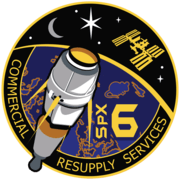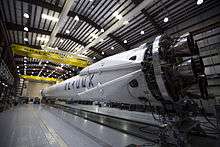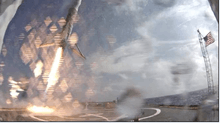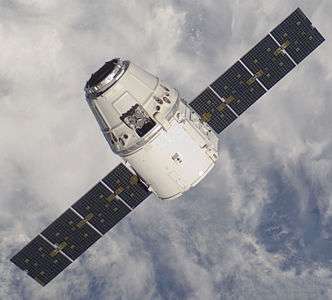SpaceX CRS-6
SpaceX CRS-6, also known as SpX-6, was a Commercial Resupply Service mission to the International Space Station, contracted to NASA. It was the eighth flight for SpaceX's uncrewed Dragon cargo spacecraft and the sixth SpaceX operational mission contracted to NASA under a Commercial Resupply Services contract. It was docked to the International Space Station from 17 April to 21 May 2015.
.jpg) The CRS-6 SpaceX Dragon spacecraft as seen from the ISS on 17 April 2015 | |
| Mission type | ISS resupply |
|---|---|
| Operator | NASA |
| COSPAR ID | 2015-021A |
| SATCAT no. | 40588 |
| Mission duration | Planned: 1 month Final: 36 days, 20 hours, 31 minutes |
| Spacecraft properties | |
| Spacecraft | Dragon C108 |
| Spacecraft type | Dragon CRS |
| Manufacturer | SpaceX |
| Start of mission | |
| Launch date | 14 April 2015, 20:10:41 UTC |
| Rocket | Falcon 9 v1.1 |
| Launch site | Cape Canaveral SLC-40 |
| Contractor | SpaceX |
| End of mission | |
| Disposal | Recovered |
| Landing date | 21 May 2015, 16:42 UTC |
| Landing site | Pacific Ocean |
| Orbital parameters | |
| Reference system | Geocentric |
| Regime | Low Earth |
| Perigee altitude | 395.6 kilometres (245.8 mi)[1] |
| Apogee altitude | 403.7 kilometres (250.8 mi)[1] |
| Inclination | 51.65 degrees[1] |
| Period | 92.55 minutes[1] |
| Epoch | 19 April 2015, 13:55:49 UTC[1] |
| Berthing at ISS | |
| Berthing port | Harmony nadir |
| RMS capture | 17 April 2015, 10:55 UTC |
| Berthing date | 17 April 2015, 13:29 UTC |
| Unberthing date | 21 May 2015, 09:29 UTC |
| RMS release | 21 May 2015, 11:04 UTC |
| Time berthed | 33 days, 20 hours |
| Cargo | |
| Mass | 2,015 kg (4,442 lb)[2] |
| Pressurised | 2,015 kg (4,442 lb) |
 NASA SpX-6 mission patch | |
Launch history
As of July 2014, the launch was tentatively scheduled by NASA for February 2015, with berthing to the station occurring two days later. However, as a result of delays in the launch of the previous SpaceX CRS-5 mission, CRS-6 launched on 14 April 2015. In late March, 2015, the launch was tentatively scheduled for 13 April 2015,[3] but was later postponed to 14 April 2015 due to weather conditions.[4]

A Federal Communications Commission application submitted for temporary communication frequency authority notes the launch planning date as no earlier than 8 April 2015. The application also confirms communication uplinks for use with the first stage of this mission as it conducts another attempt at a first-ever propulsive landing on the Autonomous spaceport drone ship after staging.[5]
.jpg)
Payload
Primary payload
NASA has contracted for the CRS-6 mission from SpaceX and therefore determines the primary payload, date/time of launch, and orbital parameters for the Dragon space capsule. The Dragon spacecraft was filled with 2015 kg (4,387 pounds) of supplies and payloads, including critical materials to directly support about 40 of the more than 250 science and research investigations that will occur during Expeditions 43 and 44.[2]
Among other items on board,
- Planetary Resources will transport an Arkyd 3—known as Arkyd 3 Reflight—to the ISS aboard Dragon on CRS-6.[6] Planetary plans to deploy the smallsat from the ISS via a NanoRacks-provided service, in an attempt to validate and mature the technology of its Arkyd series of spacecraft. This is the second Arkyd 3 satellite; in October 2014, the first Arkyd 3 satellite was destroyed on launch in the explosion of the Orbital Sciences Antares launch vehicle carrying it aboard the third Cygnus cargo resupply flight to the ISS.[7][8]
- Planet Labs will transport 14 Flock-1e Earth observation cubesat satellites for later deployment from the space station via an agreement with NanoRacks, operator of the Center for the Advancement of Science in Space (CASIS).[9]
Secondary payload
SpaceX has the primary control over manifesting, scheduling and loading secondary payloads. However, there are certain restrictions included in their contract with NASA that preclude specified hazards on the secondary payloads, and also require contract-specified probabilities of success and safety margins for any SpaceX reboosts of the secondary satellites once the Falcon 9 second stage has achieved its initial low-Earth orbit (LEO).
CRS-6 included science payloads for studying new ways to possibly counteract the microgravity-induced cell damage seen during spaceflight, the effects of microgravity on the most common cells in bones, gather new insight that could lead to treatments for osteoporosis and muscle wasting conditions, continue studies into astronaut vision changes and test a new material that could one day be used as a synthetic muscle for robotics explorers of the future. Also making the trip will be a new espresso machine for space station crews.[10]
A part of this payload includes science experiments from high schools, such as a project from Ambassador High School in Torrance, California.[11]
Return payload
Dragon returned 1,370 kg (3,020 lb) of cargo to Earth.[2]
Post-launch flight test

.jpg)
After the separation of the second stage, SpaceX conducted a flight test and attempted to return the nearly-empty first stage of the Falcon 9 through the atmosphere and land it on a 90-by-50-meter (300 ft × 160 ft) floating platform called the autonomous spaceport drone ship. The uncrewed rocket technically landed on the floating platform, however it came down with too much lateral velocity, tipped over, and was destroyed.[12] Elon Musk later explained that the bipropellant valve was stuck, and therefore the control system could not react rapidly enough for a successful landing.[13]
This was SpaceX's second attempt to land the booster on a floating platform after an earlier test landing attempt in January 2015 had to be abandoned due to weather conditions. The booster was fitted with a variety of technologies to facilitate the flight test, including grid fins and landing legs to facilitate the post-mission test. If successful, this would have been the first time in history that a rocket booster was returned to a vertical landing.[9][14]
On 15 April, SpaceX released a video of the terminal phase of the descent, the landing, the tip over, and a small deflagration as the stage broke up on the deck of the ASDS.[15]
Capsule reflight
The Dragon capsule was successfully launched again in December 2017 with CRS-13.[16]
The capsule was to make its third flight in July 2019.
See also
- List of Falcon 9 launches
References
- "DRAGON CRS6 Satellite details 2015-021A NORAD 40588". N2YO. 19 April 2015. Retrieved 19 April 2015.
- "SpaceX CRS-6 Sixth Commercial Resupply Services Flight to the International Space Station (SpaceX CRS-6)" (PDF). NASA. Retrieved 9 April 2015.
- "Launch Schedule". Retrieved 4 April 2015.
- Lawler, Richard. "SpaceX's next try at landing a reusable rocket is minutes away (update: not today)". Engadget.com. Retrieved 13 April 2015.
- "OET Special Temporary Authority Report". Retrieved 4 April 2015.
- "ARKYD: A Space Telescope for Everyone". Retrieved 10 April 2015.
- Wilhelm, Steve (16 October 2014). "First step toward asteroid mining: Planetary Resources set to launch test satellite". Puget Sound Business Journal. Retrieved 19 October 2014.
- "Antares 130 debut with fourth Cygnus ready for second attempt". Retrieved 14 April 2015.
- Graham, William (13 April 2015). "SpaceX Falcon 9 scrubs CRS-6 Dragon launch due to weather". NASASpaceFlight.com. Retrieved 14 April 2015.
- "SpaceX CRS-6 Sixth Commercial Resupply Services Flight to the International Space Station (SpaceX CRS-6)" (PDF). NASA. Retrieved 9 April 2015.
- "NanoRacks-Ambassador High School-Pollen Propulsion in a Microgravity Environment (NanoRacks-AHS-Pollen Propulsion) - 03.04.15". NASA. Retrieved 6 April 2015.
- "CRS-6 First Stage Landing". video. Retrieved 16 April 2015.
- "Elon Musk on Twitter". Twitter. Archived from the original on April 15, 2015. Retrieved April 14, 2015.
- Bergin, Chris (3 April 2015). "SpaceX preparing for a busy season of missions and test milestones". NASASpaceFlight.com. Retrieved 4 April 2015.
- CRS-6 First Stage Landing, SpaceX, 15 April 2015.
- Grush, Loren (15 December 2017). "SpaceX launches and lands its first used rocket for NASA". The Verge. Retrieved 15 December 2017.
External links
| Wikimedia Commons has media related to SpaceX CRS-6. |
- NASA
- SpaceX/NASA CRS-6 press kit, PDF, April 2015.

.jpg)

